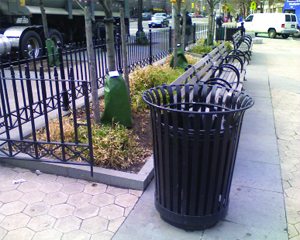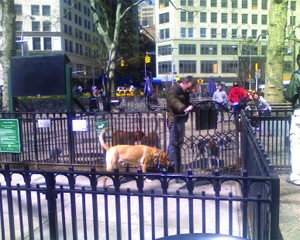By Michael Comstock –
Muddy York was once Toronto’s nickname. Sidewalks of wood and coal cinders fell apart every spring as the icy ground heaved and softened. Muddy York was the first urban reference about Toronto. Fittingly, this was a pedestrian appellation. The pendulum of city governance is now crushing the car and praising the rich pageantry of our sidewalks. Of course, being the city, our sidewalk makeover is being done on the cheap, based on advertising revenues that never completely materialize. The new garbage bins cost $2,500 each and it looks like a large plastic glob on a stick.
All over town this sameness is driving the area merchants mad. They struggle with the city, spending their own BIA fees to develop a look, flowers and banners and festivals. Merchants are trying to define their own distinctive neighbourhoods’ streetscapes. They want to foster a pride of place, be seen as unique areas. At the same time the city imposes a boring design standard. Is there not even another colour in this Astral media stuff? The complete set of benches and bins which they euphemistically call “furniture” won’t be in place for 19 years. Oh, but installing the bus shelters with big advertising is almost done.
Let’s start now on a plan to fix this mess. We can look to New York City and especially its parks. On first look at its sidewalks, we find no one sleeps on them. Not like our financial core, New York seems to recognize this behaviour is bad for the individual and the community. This behaviour will get you picked up by a police-ambulance response team and taken to an assessment centre.
 NYC is highly pedestrian and not just office workers, but families and seniors and all. Their most cherished sidewalk feature is the trees and tree pits. A more moderate climate allows for lush greens in most tree pits. Individuals, buildings and the city, all contribute to little iron fences around the tree pits and encourage natural greenery.
NYC is highly pedestrian and not just office workers, but families and seniors and all. Their most cherished sidewalk feature is the trees and tree pits. A more moderate climate allows for lush greens in most tree pits. Individuals, buildings and the city, all contribute to little iron fences around the tree pits and encourage natural greenery.
But the crowning attribute of the pedestrian realm is in their urban parks. New York trims and carefully waters trees using a bag system strapped to the tree that drips water and won’t run off. Their garbage cans are metal basket-shaped containers; simple, accessible without a lid. Is Toronto so anal that it has to have little doors on each compartment of a litter bin?
New York parks seem to be run with service to the public in mind. New Yorkers need to get outside. There is a strong demand to find quality public space to talk, read or have a snack. Responding to this demand parks have been designed to get the most out of each square foot. Green space is preserved using decorative iron fencing. Toronto would oppose decorative fencing in favour of the open lawn with lowest cost and maintenance.
The NYC Flatiron District and 23rd-Street merchants have a glorious Madison Square Park. Bryant Park is another famous example. Here a café rents space at one end where patrons provide eyes on the park. There is an antique merry-go-round operated by a charity. Tables and chairs are plentiful and can be moved to the sunny side, or placed and grouped as needed. My father told me never drink in a bar where the tables are bolted to the floor. That is usually proof of dangerous behaviour. I think Toronto bolts down most everything in the parks (with the exception of Dundas Square sometimes) then allows most any type of behaviour.
Best of show is the Madison dog park. This is a fenced-off area within the park. It is just for dogs off leash and their owners. There is a small fenced entrance area in which you unleash your dog, get bags and check over your animal. Inside it is well thought out. The ground is sand, large trees, benches and tools and bins for dog poop. You can comfortably own a dog in the city when encouraged by such a facility. The whole socialization of, not just the dogs but the dog owners, is great.
At the opposite corners is a similar iron fenced off area. It too has entrance gates but this area is for little kids only. Adults must be accompanied by a child. Equipment for kids abound in a well-thought-out space, designed for a special purpose. And, again you get high value, high usage out of smaller spaces. When you create services for people and provide more reasons to visit the park, more people come to the park.
Downtown parks need this kind of investment. Downtown residents need useful parks. Good examples for creation of these new urban parks are Toronto’s Berczy Park behind the Flatiron Building and St. James’ Park. They were new 35 years ago and now both are in decline. Capital is needed soon, since they will need to accommodate hundreds of more residents very soon. We need to balance the new Downtown population density with renewed and useful park space. Lets hope the stakeholders can pry open the civic purse.
 TheBulletin.ca Journal of Downtown Toronto
TheBulletin.ca Journal of Downtown Toronto


